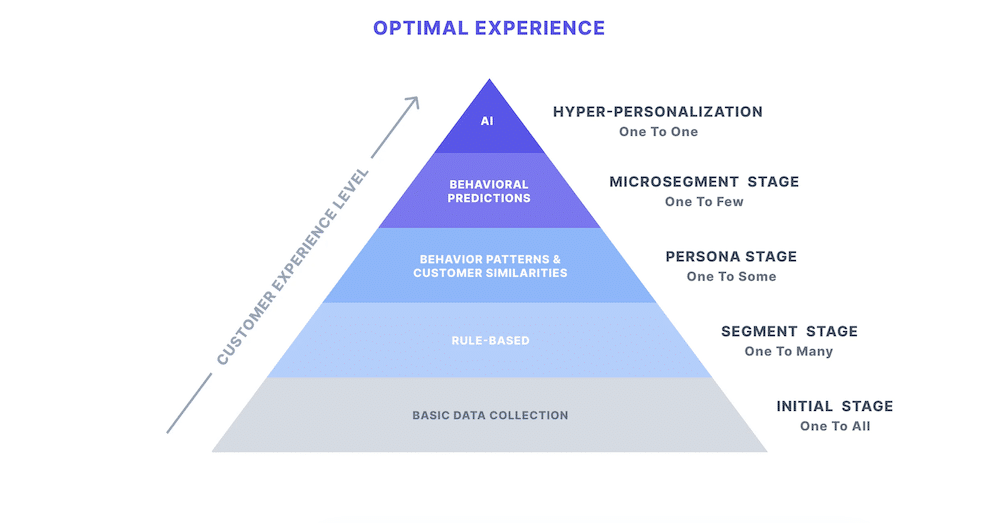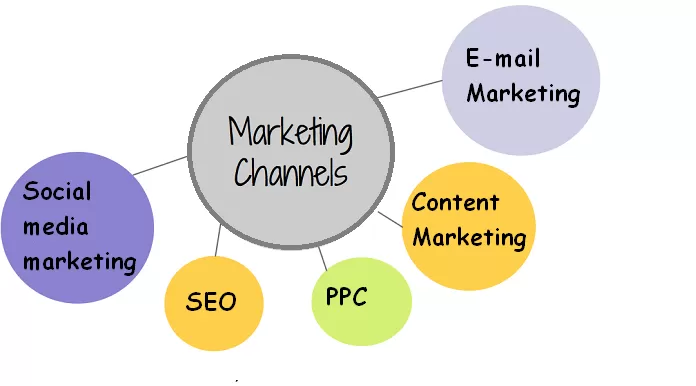In the ever-evolving realm of ecommerce, the paradigm of customer engagement is undergoing a profound transformation through the lens of hyper-personalisation, or as it will become better known, individualisation. In 2024, the concept of hyper-personalisation in ecommerce stands as a beacon, redefining the online shopping experience with unprecedented precision and relevance. Hyper-personalisation transcends traditional personalisation methods, leveraging advanced technologies like artificial intelligence and machine learning to curate individualised journeys for every shopper.
First let us decipher the essence of hyper-personalisation in the ecommerce realm, exploring its definition and unravelling the profound significance it holds in elevating online shopping to new heights of tailored and immersive customer experiences.
The evolution of ecommerce personalisation and individualisation
The journey of ecommerce personalisation traces back to the early days of online retail, marked by rudimentary attempts to tailor content based on user behaviour. Initially, basic product recommendations and personalised email campaigns paved the way for a more individual shopping experience. As technology advanced, so did the capabilities of ecommerce platforms, laying the groundwork for more sophisticated personalisation strategies.

Milestones and innovations leading to hyper-personalisation
The evolution of ecommerce personalisation has been punctuated by transformative milestones. The integration of customer data management systems, the advent of machine learning algorithms, and the application of artificial intelligence have collectively ushered in a new era of hyper-personalisation. Innovations such as predictive analytics, real-time behaviour tracking, and adaptive learning mechanisms have become integral components, enabling platforms to understand and respond to consumer preferences with unparalleled accuracy.
Impact of hyper-personalisation on consumer expectations
In the wake of hyper-personalisation, consumer expectations have undergone a seismic shift. Shoppers now anticipate not just personalised product recommendations but an entire online shopping journey curated to align seamlessly with their preferences. The impact is not solely transactional; it extends to the overall perception of brands. Consumers, accustomed to tailored experiences, now view generic approaches with a discerning eye. As hyper-personalisation becomes the new standard, brands that adeptly navigate these advancements find themselves better positioned to exceed expectations and foster lasting customer loyalty in the dynamic landscape of e-commerce.
Technological foundations
At the forefront of hyper-personalisation in e-commerce stands Artificial Intelligence (AI), a technological marvel that empowers platforms to comprehend, interpret, and respond to user behaviour in real-time, like never before. AI algorithms analyse vast datasets, enabling platforms to gain profound insights into individual preferences, purchase history, and browsing patterns. This cognitive capability forms the cornerstone of delivering a personalised shopping journey that transcends conventional boundaries.
Machine Learning (ML) algorithms play a pivotal role in the evolution of hyper-personalisation and individualisation, dynamically adapting and improving based on user interactions. By continuously learning from user behaviour, these algorithms refine product recommendations, optimise pricing strategies, and enhance the overall user experience. The iterative nature of machine learning ensures that the ecommerce platform or more importantly your relationship built with each consumer offline as well as on it, specifically through email communication, becomes increasingly adept at anticipating and fulfilling the unique needs of each customer.
In the era of hyper-personalisation, data analytics serves as a compass, guiding ecommerce platforms through the vast seas of consumer information. Advanced analytics & email communication tools, such as SwiftERM, dissect customer insights, extracting valuable information that goes beyond transactional history. By understanding the intricacies of consumer preferences and anticipating future needs, ecommerce entities can craft tailored shopping experiences that resonate on a personal level, fostering a deeper connection between the consumer and the platform.
Real-time personalisation in action
In 2024, real-time personalisation will emerge as a defining marketing trend, transforming how ecommerce platforms engage users. Dynamic content delivery ensures that every element, from homepage displays to product listings, adapts instantaneously to user behaviour. Hyper-personalised product recommendations, driven by advanced algorithms and AI, guide users through an individualised shopping journey, presenting products aligned with their preferences at the moment.
As a noteworthy marketing trend, adaptive pricing models take centre stage in hyper-personalisation. Ecommerce platforms leverage real-time data analytics to dynamically adjust pricing based on individual user interactions. Personalised discounts, tailored to a user’s shopping history and behaviour, create a sense of exclusivity. This enhances user satisfaction and contributes to the overall marketing trend of fostering customer loyalty through tailored and strategic pricing strategies.
As of 2024, real-time personalisation stands not only as a technological advancement but also as a powerful marketing trend reshaping the landscape of ecommerce. The ability to dynamically adapt content, provide precise product recommendations, and implement personalised pricing models positions this approach at the forefront of strategies aimed at creating a more engaging and customer-centric online shopping experience.
Customer Journey Mapping
In the landscape of hyper-personalisation, the customer journey evolves into a meticulously crafted expedition tailored to individual preferences. Understanding the hyper-personalised customer journey involves mapping out every interaction, from the initial point of entry to the final purchase. Through sophisticated algorithms and AI, ecommerce platforms gain insights into user behaviour, allowing them to predict and meet the unique needs and expectations of each customer at every stage. Although to wait for the shoppers to come to you to use is vanity, you must take it to them, just as your competitors will.
In 2024, the hyper-personalised customer journey transcends mere product recommendations. It extends across diverse touchpoints, from the homepage to the checkout page, ensuring a cohesive and individualised experience. Show them the products they have already told you they are most likely to buy next. The homepage dynamically adjusts to showcase relevant content, personalised based on browsing history, navigation patterns, and repetition of CTRs all of which illustrate preferences. As users progress through the journey, personalised promotions, tailored product suggestions, and a seamlessly adapted interface create a sense of continuity, offering a shopping experience that feels exclusively crafted for each individual.
In this era of hyper-personalisation, customer journey mapping becomes a strategic imperative, redefining how ecommerce platforms navigate the digital terrain and ensuring that every touchpoint resonates with customers on a deeply personal level. You don’t need to invest millions I implementing your data science department. Specialist plugins are already there and enormously beneficial, far beyond the time it would take you to catch up.
Challenges and Solutions
While hyper-personalisation heralds a new era in ecommerce, it is not without its challenges. Chief among these is the heightened concern for user privacy. As personalisation relies heavily on user data, there is a delicate balance to strike between providing a tailored experience and safeguarding user information. With consumers increasingly mindful of their privacy, navigating the intricacies of data usage becomes a paramount challenge.
In 2024, maintaining consumer trust is integral to the success of hyper-personalisation strategies. Ecommerce software must implement robust measures to address privacy concerns and assure users that their data is handled ethically and responsibly. Transparent communication about data usage policies, obtaining explicit consent, and investing in advanced cybersecurity measures are crucial steps in building and preserving consumer trust. Striking the right balance ensures that hyper-personalisation not only enhances the online shopping experience but also fosters a relationship of trust and confidence between consumers and ecommerce retailers. As the industry evolves, finding innovative solutions to these challenges becomes imperative to sustain the momentum of hyper-personalisation in redefining the online shopping landscape.
A superb follow-up article: Individualisation, hyper-personalisation and self-obsession.
The impact on conversion rates and customer loyalty
One of the compelling aspects of hyper-personalisation in e-commerce is its profound impact on conversion rates. By leveraging data analytics and AI algorithms, ecommerce platforms can analyse user behaviour with unprecedented precision. This data-driven approach enables the fine-tuning of product recommendations, pricing strategies, and the overall shopping experience. As a result, conversion rates witness significant improvements, translating into more successful transactions and increased revenue for businesses.
Beyond the immediate benefits of enhanced conversion rates, hyper-personalisation and individualisation play a pivotal role in cultivating long-term customer relationships. By consistently delivering personalised messages as product recommendations, ecommerce retailers foster a sense of connection and understanding with their customers. This personalised approach contributes to customer satisfaction, building trust and loyalty over time. In the dynamic landscape of 2024, where consumers seek not just transactions but meaningful interactions, hyper-personalisation emerges as a key driver in establishing and nurturing enduring relationships between ecommerce entities and their customers.
Conclusion
In summary, hyper-personalisation in ecommerce emerges as a transformative force in 2024, reshaping the online shopping experience. The profound impact on individualisation, driven by AI and data analytics, has elevated customer engagement to new heights. As we conclude, the key takeaway is the imperative of continuous adaptation to ever-changing consumer expectations. Ecommerce entities that prioritise agility, anticipate needs and deliver personalised interactions will not only meet but exceed the dynamic demands of today’s discerning consumers, solidifying their standing in the evolving landscape of the ecommerce winners because of hyper-personalisation.





